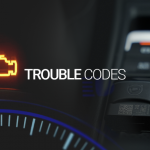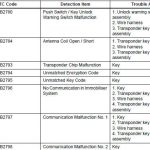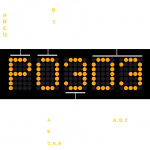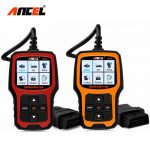This article will go over the categories, meaning, and readability of Diagnostic Trouble Codes. Hopefully it will help you to understand your car’s trouble codes. However, you should keep these tips in mind:
Diagnostic Trouble Codes
When your check engine light comes on, you’ve probably wondered what these diagnostic trouble codes are. They are simply 5 digits, each consisting of a letter and 4 numbers, which identify a particular problem with your vehicle. These codes can be located on the dashboard or displayed on a scanner connected to your car’s OBD system. Each DTC has a specific fault description and is meant to help your mechanic determine what the problem is.
The first digit of a DTC identifies its manufacturer, while the second is a two-digit number between 0 and 99. The second digit of a DTC is a generic code, and the third digit identifies its subsystem. Previously, the second digit defined the type of fault index, or problem, the vehicle is experiencing. However, a recent document has streamlined the definition of DTCs and removed the distinction between DTCs and fault indexes.
Real-time vehicle diagnostics can pinpoint issues before they reach a critical stage. This information can help you determine what the problem is, as well as find the closest service center to repair it. However, some DTC fault codes are not critical, but they still need attention, such as the P030X code for cylinder misfire. However, if your vehicle is emitting pollutants, the DTC will send you a code that indicates this.
While the underlying cause of any problem may be different in each vehicle, understanding diagnostic trouble codes can be helpful in limiting unnecessary diagnostics. Knowing what these codes mean will empower you to be an active participant in the process of car repair. By understanding how these codes work, you’ll be able to prevent and repair problems before they become major. If you’re a car owner who’s curious about the code, here are some tips to help you figure out what it means for your car and your driving style.
Meaning
When you drive your car, you might see various warning messages that your car will display. Some of these messages have specific meanings. Trouble codes come in many different forms. One code may indicate that something is wrong with the transmission while another may mean a sensor is failing. Regardless of what type of trouble code your car displays, knowing what it means is essential to keeping your vehicle safe and on the road. Listed below are some of the most common codes and their meanings.
The computer within your car uses trouble codes to help identify specific elements or areas of the vehicle that need repair. When this happens, the CEL will illuminate, indicating a problem. Common trouble codes may be related to failing sensors, fuel, ignition, or mechanical components. They can also affect fuel economy, tailpipe emissions, and your overall driving experience. To learn what the code means, contact your mechanic or car service center. It is important to understand what each code means and why it is illuminated.
The most common trouble codes are DTC, OBD-II, and J1939. Each code represents a specific problem that the car may be having. If you are unsure what the code means, contact your dealership and ask for a free diagnostic. These diagnostic tests are a great way to ensure your vehicle is safe to drive and will improve your fleet’s ROI. If you don’t know what a code means, you can learn more about the trouble codes that are on your car.
Categories
A car’s trouble code is a series of digits that refer to a malfunction. The first two digits refer to the exact sensor within the OBD II network. The P codes refer to the engine and powertrain, while B, C, and U codes refer to different systems and components. While a repair technician will likely scan the car’s OBD II system to find a specific P-code, you can also read and interpret the codes yourself to determine which part of your vehicle is malfunctioning.
When using a diagnostic tool, you’ll need specialized equipment to read these codes. Depending on your vehicle, you may need a special scanner or specialized equipment. Diagnostic connectors are often the most common type of code reader. Basic code readers are typically not capable of deciphering the meaning of the code, and may only give you the code number. In addition, you’ll need a specific database for your particular model of vehicle, so make sure you buy a model-specific code reader.
How to read them
When you’re driving your car, you may notice that your check engine light is on or says “service engine soon.” If this is the case, it indicates that something is wrong with the engine’s management system. If you’d like to know how to read trouble codes, you should watch this automotive video tutorial. You’ll learn everything you need to know about how trouble codes are generated and how to determine what they mean. The video will also explain how to diagnose and troubleshoot common problems in your car, and how to interpret them.
There are two types of DTCs: those indicating emissions and those that indicate a malfunction. DTCs, or Diagnostic Trouble Codes, are codes stored in the car’s onboard computer system. The main purpose of these codes is to warn drivers when a problem is detected with their vehicle. A car’s computer stores them in two different locations. These are the Engine Control Module and the Powertrain Control Module. You can read trouble codes by using a scanner or a diagnostic tool.
The third character in a DTC is a digit ranging from one to eight. The fourth and fifth characters indicate a specific problem with a certain part or system of your car. If you’re struggling to decipher a DTC, use an OBDeleven device. You’ll be amazed at how many different codes your car has! The OBDeleven device can help you figure out which one is the root of your vehicle’s problems and solve them.
Diagnostic trouble codes are codes created by the OBD system to let car owners know what’s wrong with their vehicle. Each code is unique, and only the car manufacturer can tell you which one is causing the problem. Trouble codes are easy to interpret if you know the format of the codes. You can learn more about the trouble codes on your car’s computer by reading the manual that came with the vehicle. This can help you avoid costly repairs.






